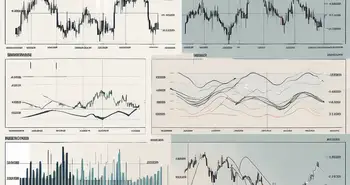Article Contents
Understanding the Arbitrage Pricing Theory: A Comprehensive Guide

Arbitrage Pricing Theory (APT) is a widely used framework in finance that helps investors understand the relationship between asset prices and their underlying risk factors. By analyzing these factors, investors can estimate the fair value of an asset and potentially find mispriced opportunities for arbitrage.
What is Arbitrage Pricing Theory?
Arbitrage Pricing Theory is a multifactor model that seeks to explain asset prices by considering the effect of different risk factors. Unlike the traditional Capital Asset Pricing Model (CAPM), APT incorporates multiple factors that may influence an asset's expected return. These factors can include macroeconomic variables, industry-specific factors, and company-specific attributes.
Arbitrage Pricing Theory is a widely used framework in finance that provides insights into the relationship between risk and return. It is based on the idea that investors should be compensated for bearing systematic risks, which cannot be diversified away. By considering multiple factors, APT offers a more comprehensive understanding of asset pricing compared to the simplistic assumptions of the CAPM.
APT assumes that an asset's return is driven by a combination of systematic risk factors that cannot be diversified away. The theory suggests that investors should be compensated for bearing these risks, and as a result, an asset's expected return is directly related to its exposure to these factors.
In practice, APT is often used to construct a pricing equation that relates an asset's expected return to its risk factors. This equation allows investors to estimate the fair value of an asset based on the current market conditions and the associated risk factors. By considering multiple factors, APT provides a more nuanced approach to valuing assets, taking into account the various sources of risk that can impact an asset's return.
Definition and Basic Principles
At its core, APT assumes that an asset's return is driven by a combination of systematic risk factors that cannot be diversified away. These risk factors can include changes in interest rates, inflation, exchange rates, and other macroeconomic variables. Additionally, APT considers industry-specific factors such as technological advancements, regulatory changes, and market competition. Furthermore, company-specific attributes like financial health, management quality, and growth prospects are also taken into account.
The basic principles of APT revolve around the idea that investors should be compensated for bearing systematic risks. The theory suggests that the expected return of an asset is directly related to its exposure to these risk factors. By understanding and quantifying these factors, investors can make more informed decisions about the fair value of an asset and its potential for future returns.
One of the key advantages of APT is its ability to capture a broader range of risk factors compared to the CAPM. While the CAPM only considers the market risk, APT incorporates multiple factors that can influence an asset's return. This allows for a more accurate assessment of an asset's risk and expected return, leading to better investment decisions.
The Role of Arbitrage in Financial Markets
Arbitrage plays a crucial role in APT. Arbitrageurs capitalize on mispriced assets by simultaneously buying and selling related assets to exploit pricing inconsistencies. By taking advantage of these opportunities, arbitrageurs help restore market efficiency and align prices with their fundamental values.
Arbitrageurs seek to eliminate mispricings that arise due to factors not considered by the APT model. Their actions help ensure that asset prices accurately reflect the underlying risk factors, thus maintaining market integrity and enhancing market efficiency.
Arbitrageurs play a vital role in the financial markets by identifying and exploiting pricing discrepancies. They contribute to market liquidity and help reduce market inefficiencies. Through their actions, arbitrageurs help align asset prices with their fundamental values, making markets more efficient and ensuring fair valuations.
It is important to note that arbitrage opportunities are often short-lived as market participants quickly react to exploit these mispricings. As a result, arbitrageurs must act swiftly to take advantage of these opportunities before they disappear. Their actions not only benefit themselves but also contribute to the overall efficiency and stability of financial markets.
In conclusion, Arbitrage Pricing Theory is a multifactor model that considers the effect of various risk factors on asset prices. By incorporating multiple factors, APT provides a more comprehensive understanding of asset pricing and helps investors estimate the fair value of an asset. Arbitrageurs play a crucial role in APT by capitalizing on mispriced assets and restoring market efficiency. Their actions help align prices with their fundamental values, contributing to the overall integrity and efficiency of financial markets.
The Mathematical Framework of Arbitrage Pricing Theory
Understanding the mathematical framework of Arbitrage Pricing Theory (APT) is essential for accurately applying the theory and making informed investment decisions. APT involves two key components: risk factors and the arbitrage pricing equation.
When delving into APT, it is crucial to grasp the concept of risk factors. Risk factors in APT represent the systematic sources of risk that have an impact on an asset's return. These factors can be derived from various economic indicators, industry-specific variables, or even company-specific attributes. Examples of common risk factors include interest rates, inflation rates, GDP growth, and industry-specific performance metrics.
Identifying the relevant risk factors for a particular asset or investment strategy is of utmost importance. By determining which factors have the most significant impact on an asset's return, investors can adjust their portfolio weights accordingly. This adjustment allows them to potentially achieve superior risk-adjusted returns, as they are aligning their investments with the factors that are most likely to influence returns.
Now, let's delve deeper into the arbitrage pricing equation, which lies at the heart of APT. The arbitrage pricing equation represents the relationship between an asset's expected return and its exposure to risk factors. This equation is expressed as:
- Excess Return = Risk Factor 1 Coefficient * Factor 1 + Risk Factor 2 Coefficient * Factor 2 + …
The coefficients in the equation represent the sensitivities of an asset's return to its exposure to each specific risk factor. By estimating these coefficients, investors can determine the relative importance of each risk factor in explaining an asset's expected return. This understanding allows investors to make informed decisions regarding portfolio allocation and risk management.
It is worth noting that the arbitrage pricing equation provides a framework for assessing an asset's expected return based on its exposure to risk factors. This equation is a powerful tool that helps investors understand the underlying drivers of an asset's performance and make informed investment decisions.
In conclusion, a solid understanding of the mathematical framework of APT, including risk factors and the arbitrage pricing equation, is crucial for accurately applying the theory and making informed investment decisions. By identifying relevant risk factors and estimating their coefficients, investors can align their portfolios with the factors that are most likely to influence returns, potentially achieving superior risk-adjusted returns.
Assumptions Behind the Arbitrage Pricing Theory
APT relies on several key assumptions that shape its applicability and interpretation. Understanding these assumptions is critical for correctly using the theory.
The Role of Diversification
One of the core assumptions of APT is that investors hold well-diversified portfolios. This assumption is crucial because diversification eliminates unsystematic risk, allowing investors to focus solely on the systematic risk factors present in the market. Without diversification, it would be challenging to isolate the effects of individual risk factors.
By diversifying their portfolios, investors reduce the impact of idiosyncratic risk while retaining exposure to systematic risk, which is essential for capturing expected returns according to APT.
Assumption of Perfect Markets
Another assumption of APT is that markets are perfectly efficient, which implies that there are no transaction costs, no restrictions on short selling, no taxes, and no asymmetric information. While this assumption may not hold in real-world markets, it provides a useful benchmark for understanding the relationship between asset prices and their underlying risk factors.
It is important to consider the limitations and potential deviations from perfect market conditions when applying APT in practice. However, the underlying principles of the theory can still provide valuable insights into asset pricing.
Limitations of the Arbitrage Pricing Theory
While APT offers a robust framework for understanding asset pricing, it is not without its limitations. It is essential to be aware of these limitations when applying the theory in practice.
Practical Challenges in Application
The application of APT requires the identification and estimation of relevant risk factors. This process can be challenging, as different asset classes and investment strategies may require unique sets of risk factors. Furthermore, accurately estimating the coefficients in the arbitrage pricing equation can be complex and subject to model error.
To overcome these challenges, it is crucial to carefully select risk factors based on sound economic and financial reasoning and to employ rigorous quantitative techniques for estimating coefficients.
Criticisms and Controversies
APT has been subject to various criticisms and controversies in the academic and financial communities. Some argue that APT's reliance on historical data for estimating coefficients may not adequately capture future risk-return relationships.
Others question the assumption of well-diversified portfolios, suggesting that investors may not always hold fully diversified positions due to various constraints. Additionally, some argue that APT may fail to explain extreme events or market anomalies that cannot be explained by traditional risk factors.
Comparing Arbitrage Pricing Theory and Capital Asset Pricing Model
It is essential to note the similarities and differences between APT and CAPM, as both models provide valuable insights into asset pricing.
Similarities and Differences
APT and CAPM share common ground in their focus on exploring the relationship between risk and expected returns. However, CAPM is a single-factor model that considers only market risk, while APT is a multifactor model that incorporates multiple risk factors.
While CAPM provides a straightforward approach to estimating expected returns based on a single risk factor, APT offers a more comprehensive framework by considering additional risk factors that may impact asset prices. This makes APT more flexible and potentially more accurate in capturing the complexities of asset pricing.
Choosing the Right Model
Deciding which model to use ultimately depends on the specific investment context and the availability of relevant data. CAPM is often favored when analyzing broad-based market indices or when a single risk factor is presumed to dominate. On the other hand, APT may be more appropriate for specialized investment strategies or when multiple risk factors are believed to influence asset prices.
As an expert in the field of finance, I have seen firsthand the power of APT in understanding and predicting asset prices. By carefully considering the risk factors at play and utilizing sound quantitative techniques, investors can gain a more nuanced understanding of asset pricing dynamics and potentially identify unique investment opportunities.
One personal advice I would like to share is the importance of staying updated with the latest research and developments in APT. As financial markets and economic conditions evolve, new risk factors may emerge and existing factors may change in importance. By staying informed, you can ensure that your investment strategies remain relevant and aligned with the current market environment.
FAQ – Understanding the Arbitrage Pricing Theory
What is Arbitrage Pricing Theory (APT)?
Arbitrage Pricing Theory (APT) is a framework that seeks to explain asset prices by considering the relationship between an asset's expected return and its exposure to various systematic risk factors.
How does APT differ from the Capital Asset Pricing Model (CAPM)?
While both APT and CAPM explore the relationship between risk and expected returns, APT is a multifactor model that considers multiple risk factors, whereas CAPM is a single-factor model that focuses on market risk.
What are the key assumptions of APT?
APT assumes that investors hold well-diversified portfolios and that markets are perfectly efficient. These assumptions provide a foundation for understanding the relationship between asset prices and their underlying risk factors.
What are the limitations of APT?
Some limitations of APT include the challenges in identifying and estimating relevant risk factors and potential deviations from perfect market conditions. APT has also faced criticism for its reliance on historical data and assumptions.
Which model should I use, APT or CAPM?
The choice between APT and CAPM depends on the specific investment context and the availability of relevant data. CAPM is often used for broad-based market analysis, while APT may be more suitable for specialized strategies that incorporate multiple risk factors.
In conclusion, Understanding the Arbitrage Pricing Theory is essential for investors seeking to gain deeper insights into asset pricing dynamics. By considering the role of risk factors and adhering to sound quantitative techniques, investors can potentially identify mispriced assets and make informed investment decisions. Stay informed, stay focused, and let APT guide you towards better investing strategies.
Ready to put the insights from Arbitrage Pricing Theory into action? Morpher.com offers a revolutionary trading experience that aligns perfectly with the sophisticated strategies discussed in this guide. With zero fees, infinite liquidity, and the ability to trade across a multitude of asset classes, Morpher empowers you to apply APT principles in real-time. Whether you're looking to invest fractionally or take advantage of 10x leverage, Morpher's blockchain-based platform is designed to elevate your trading game. Sign Up and Get Your Free Sign Up Bonus today to start trading with an edge.

Disclaimer: All investments involve risk, and the past performance of a security, industry, sector, market, financial product, trading strategy, or individual’s trading does not guarantee future results or returns. Investors are fully responsible for any investment decisions they make. Such decisions should be based solely on an evaluation of their financial circumstances, investment objectives, risk tolerance, and liquidity needs. This post does not constitute investment advice.

Painless trading for everyone
Hundreds of markets all in one place - Apple, Bitcoin, Gold, Watches, NFTs, Sneakers and so much more.

Painless trading for everyone
Hundreds of markets all in one place - Apple, Bitcoin, Gold, Watches, NFTs, Sneakers and so much more.








